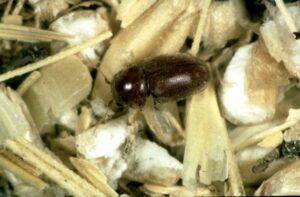
Lasioderma serricorne (Tobacco beetle) CSIRO, 2007. CSIRO (CC BY 3.0)
This Collections Care document has been produced using information from our Conservation Development Officer, Helena Jaeschke.
This resource will provide information on identifying and dealing with Biscuit & Tobacco Beetles in your museum collection.
Biscuit Beetle & Tobacco Beetle
(Stegobium paniceum & Lascioderma serricorne)
Size
Adult 2-3mm, larva up to 3 mm long
Favourite Food
Hard starchy plant materials especially seeds, dried food (like pasta and biscuits), also taxidermy or dried animal specimens and books.
What to look for
- Larva – Cream coloured grub-like body, usually hidden inside the object.
- Adult – Reddish-brown, slightly hairy oval beetle. Biscuit beetle antennae have three small blobs at the end, like beads. Tobacco beetle antennae are like a string of 11 beads
Two very small beetles which do a disproportionate amount of damage in museum
collections. They are related to the Furniture beetle (also known as woodworm) and leave similar (but smaller) exit holes when they emerge as adults from the object they have been chewing through for weeks. You may have seen these in the home, infesting old packets of biscuits, pasta or grain but they will eat a wide variety of dry plant materials and even some animal specimens or books if the binding has enough starch or animal glue. They can devastate herbarium collections of dried plants.
Sometimes the powdery grains of insect droppings (frass) which fall from the exit holes, reminiscent of woodworm, are the most obvious evidence of an infestation. Food-based props such as loose grain or nuts, dried bread, biscuits or dough may introduce the pests as eggs. Once the larvae have developed into adults they can chew their way out and infest the collection. In warm weather the life cycle can take a few weeks, in colder weather it is usually several months.
Although they are superficially similar and attack similar types of objects, they can be distinguished with good magnification.
Biscuit beetles
- Parallel lines of pits running along the back of the wing-cases and often look rather dusty.
- Three segments like beads at the end of their antennae.
Tobacco beetles
- Smoother wing cases which seem more shiny,
with sparser hairs. - Segmented antennae like a string of eleven beads.
Check your pest traps weekly once you have spotted beetles and record how many you find in each. This can help you track the source. Don’t forget areas where food is kept or consumed in the museum. Put out more traps especially near entrances that insects could use – roof hatches, vents and gaps between floorboards may all be entry points. Use flying insect traps and Demi-Diamond wall traps as well.
Actions
- Be scrupulous about housekeeping – empty bins daily and make sure food residues are cleaned up.
- Have traps in all areas, especially where people hang up coats and bags – they can bring beetles in unknowingly (or carry them home!)
- Deep clean areas where there may be an infestation – move all boxes, vacuum floors and wipe shelves. You can use a museum-suitable permethrin-type pesticide like Constrain to spray in cracks in walls, floors, under skirting boards but not on objects.
- If you find infested objects, pick off any live pests you find, then isolate the objects by wrapping them in acid-free tissue and then in polythene sheet and sealing ALL the edges with parcel tape. Contact a conservator (or the CDO if your museum is in the South West) for treatment advice.
- Don’t forget – other pests may also be damaging the collection. Look out for more pests in our monthly series
